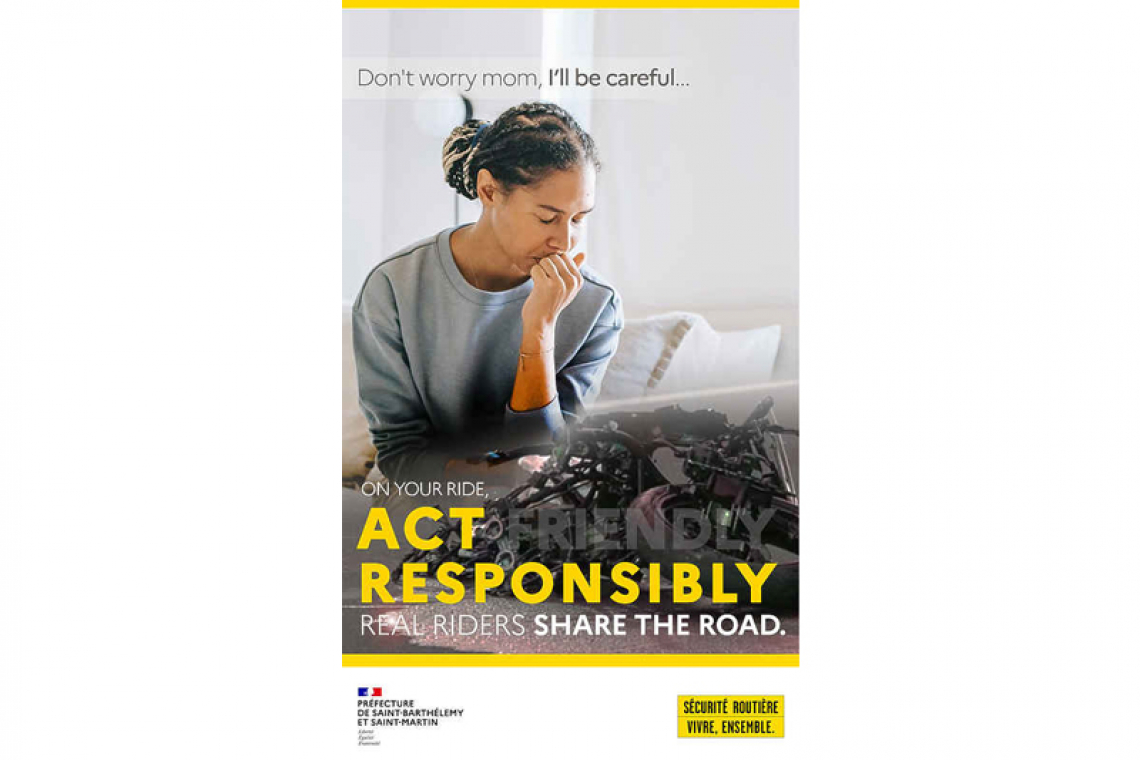A road safety awareness campaign flyer.
MARIGOT--The Préfecture has launched a road safety awareness campaign targeting young people ages 15-25 years, particularly those riding scooters and motorbikes, between now and March 12 with visuals published every Friday.
On average seven young people 14-24 years old lose their lives on a motorbike in St. Martin and St. Barths every year. Smaller and often located in blind spots, a motorbike is always less visible than a car. Other users are surprised to see a two-wheeled vehicle appear at a crossroads, between lanes or in a bend.
Disrespectful behaviour towards others and a careless attitude on the road (speeding, acrobatics, untimely overtaking) mean that the driver is not mature enough to use a motorbike. Two-wheeled driving implies being civic-minded, for oneself and for one’s family and friends.
The vehicle must be equipped with one or two headlights at the front; one or two stop-lights and a red reflector at the rear; main-beam headlight; turn indicators; and rear number plate light.
For clothing one is advised to give priority to bright, fluorescent, visible light, etc. Even though motorbike equipment is often offered in black, there are light or fluorescent jackets available.
Likewise, for helmets one shouldn’t hesitate to choose a model that stands out: all manufacturers now offer them. If equipment does not have reflective strips, it is important to add them and use reflective armbands.
The wearing of a high visibility waistcoat is mandatory in case of emergency. As soon as the moped or motorbike rider gets off the vehicle, he or she must put it on. The rider should therefore always have one – in the toolbox, in his/her top-case or satchel, or in a jacket pocket – and it should be put on as soon as possible in case of an accident or emergency stop.
The rider is advised not to forget their passenger. To be clearly visible to other drivers, it is important to equip one’s passenger with reflective strips or a reflective waistcoat. Sitting behind the motorbike rider, the passenger can make the rider’s own retro-reflective elements invisible.
Light colours are recommended for motorbikes. The colour attracts the eye of other drivers who will see the rider more easily. One should check that lights are approved (art. R313-1 et seq.) and regularly check that they are clean and working properly.
The failure of a two-wheeler’s turn indicator is a real danger. Checking that they are working properly should therefore be included in one’s daily check-up. Any sudden change of direction is a danger on the road.
In a majority of accidents involving a motorcyclist and a third party, the driver of the other vehicle declares, “I didn’t see the motorbike.” This is found in almost two-thirds of accidents involving a car and a two-wheeler.
It is advised to drive in the third of the lane provides the most visibility and best safety margins. It is essential to establish visual contact with other drivers. Otherwise, riders should assume that they have not been seen, and when in doubt, should always reduce their speed. Riders should avoid being in the blind spots of other vehicles and accept that the road is not a playground and is shared with other road-users.







